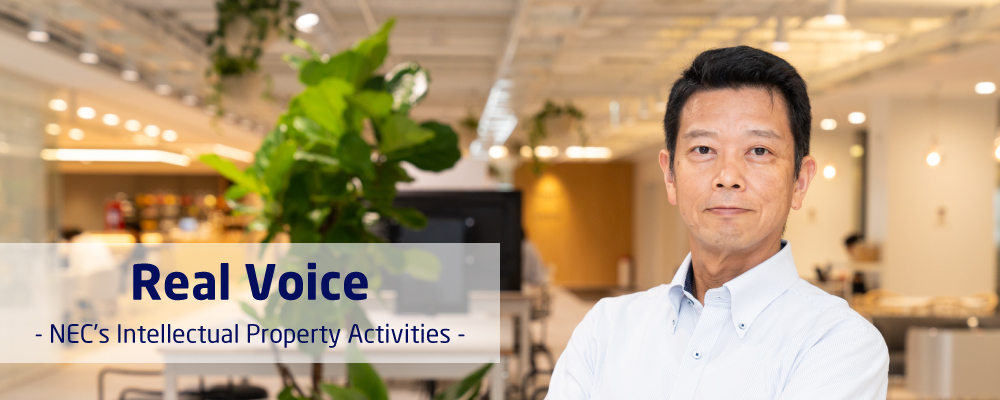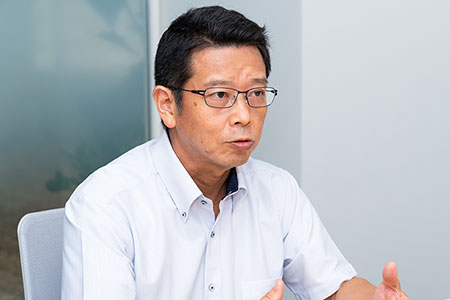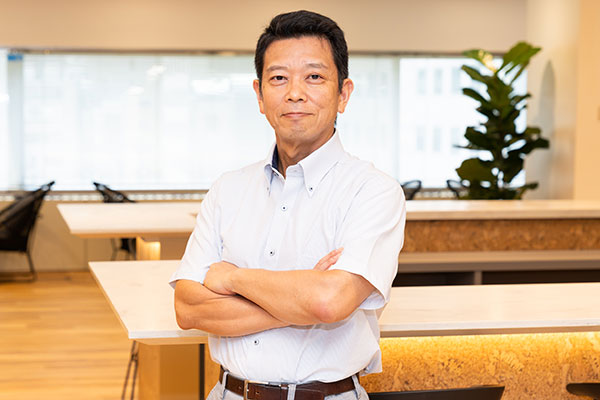Global Site
Breadcrumb navigation
Interview

Enhancing Corporate Value Through Strategic Licensing
September 5, 2024
As the Internet of Things (IoT) continues to evolve and technologies from different industries intersect, licensing – the act of granting companies the right to use patents owned by others in exchange for compensation – has become an increasingly important practice. NEC, which holds numerous key patents related to IoT, has successfully negotiated numerous licensing agreements. To gain deeper insights into the goals and activities of NEC's Intellectual Property Management Division, the division responsible for licensing activities, we spoke in detail with the director overseeing these efforts.
Profile

Toshiyasu Kurasugi joined NEC as a researcher in 1996. He initially focused on evaluating network system performance and conducting research and development in content delivery networks, among other projects. Driven by a broad interest in cutting-edge technologies, he later qualified as a patent attorney and transferred to the Intellectual Property Management Division in 2007. In 2010, he was assigned to NEC Europe Ltd., where he supported the creation of standard essential patents (SEPs) for cellular communications. Returning to NEC in 2013, he took on a managerial role in the licensing activities of the Intellectual Property Management Division. Since 2021, he has been actively involved in licensing and contract drafting projects in his current position.
Toshiyasu Kurasugi
Director
Licensing Department
NEC is one of Japan’s top-tier holders with over 1,000 standard essential patents
What activities does the Licensing Department within NEC’s Intellectual Property Division engage in?
The Licensing Department focuses on three main areas: intellectual property licensing, contract work, and transactions.
The first area is managing the licensing of intellectual property – including patents, know-how, and software copyrights. Activities in this area involve negotiating agreements for the purposes of licensing out NEC’s patents to other companies and to license in patents owned by others for NEC's use. While we often negotiate directly with companies for licensing-out agreements, we also make use of patent pools, which bundle patents from multiple companies to make them more easily accessible to various businesses.
The second area is contract work. In addition to working on license agreements, we review intellectual property clauses in various contracts that are essential for advancing our business. Specifically, we often review intellectual property indemnity clauses in purchasing contracts for our business divisions and R&D divisions, as well as clauses related to intellectual property management in joint application and joint development agreements.
Lastly, the third and final area is the handling of the negotiations for the purchase or sale of patents and other intellectual property assets.
It seems that you manage a wide range of activities. Today, we would like to focus on your licensing business, particularly your licensing-out operations. Could you tell us more about those activities?
Certainly. One of our most significant licensing-out activities involves standard essential patents (SEPs). SEPs are patents crucial for implementing global standards set by standards organizations. For instance, deploying mobile communication systems can require thousands, if not tens of thousands, of SEPs. At NEC, we hold a significant number of SEPs for technologies such as 4G/5G cellular communications and audio/video codecs. In fact, our SEP portfolio exceeds 1,000 patent families,1 making it one of the largest in the country.

NEC views the intellectual property it has developed through significant investments to be a vital management resource. In recent years, we have expanded our licensing-out efforts to include not just patents, but also know-how and software as well. My team is also actively involved in licensing out our know-how and software related to mobile communications technology.
You mentioned that a significant portion of your licensing-out activities involve standard essential patents, likely due to the large number of SEPs NEC holds. Why does NEC hold so many of these patents?
NEC has been deeply involved in infrastructure projects such as base stations in the cellular communications sector for many years and also have maintained a long-standing presence in the broadcast video industry. To stay at the forefront of these fields, it is essential to research and develop technologies that adhere to global standards, which means actively participating in standardization activities. Through the combination of research, development, and standardization efforts, we have naturally accumulated a large number of standard essential patents.
It is not enough to simply following existing standards to stay profitable and competitive in these industries – instead, we must also take the lead in standardization activities. Our R&D engineers have actively participated in these efforts for years, working closely with our Intellectual Property Management Division to create and secure patents. This teamwork has enabled us to build a substantial portfolio of standard essential patents that meet global standards. By working closely together, our engineers and intellectual property team ensure that our patents are both numerous and of high quality. In fact, independent reports consistently rate our products highly for their compliance with standards.
- 1 After a patent application is filed, similar applications can be filed in other countries, and these are often grouped together and recorded as a family.
Using intellectual property revenue to invest in future R&D and intellectual property
What value does holding a large number of high-quality standard essential patents bring to corporate activities?
As I mentioned previously, using technology that conforms to industry standards is essential in our business areas. Owning a large number of high-quality SEPs provides significant market value. It can also be said that it serves to validate our technical capabilities.

On the other hand, to promote the widespread adoption of these standards and encourage technological innovation through healthy competition, SEP holders are required to license their SEPs on fair, reasonable, and non-discriminatory (FRAND) terms to ensure broad accessibility.
At NEC, we handle the licensing of our SEPs in accordance with this principle. Since we also produce products that comply with these standards, we find ourselves in the position of being both a holder and an implementer of SEPs. Therefore, we sometimes need to license SEPs from other companies as well As such, whether we are licensing in or licensing out, we are committed to treating all parties fairly and consistently.
However, acquiring and maintaining patents requires significant investment in R&D and patent protection. As a company, we must ensure we receive a return on this said investment. This means we need to generate consistent and planned profits from our intellectual property as well, and work towards building a structure for reinvesting said profits into further R&D and IP initiatives. To achieve this, it is essential to acquire a large number of high-quality patents that meet standard specifications and to license them out on reasonable terms to generate revenue.
Towards sustainable intellectual property revenue
So, is your goal going forward to monetize your patents?
Yes, our goal is to consistently generate revenue by licensing out the valuable patents that our engineers and patent attorneys have secured. We are actively negotiating licenses directly with other companies and have already begun to see revenue from these efforts.
In addition to directly negotiating with individual companies, we also actively consider participating in patent pools as another means of licensing out our technology. For example, we have been consistently generating revenue through the HEVC video compression codec patent pool. Anticipating the era of connected cars, we joined the Avanci Vehicle program, which connects cellular communications patent holders with automakers, and have successfully generated revenue through this licensing initiative as well.
Patent pools can be an efficient licensing strategy, as they bring together multiple rights holders and simplify the negotiation process for implementers by offering a one-stop solution. However, they may be less effective not enough licensors participate. We carefully evaluate whether to utilize patent pools or to pursue direct negotiations based on each situation.
Our goal is to establish a sustainable cycle in which we consistently earn revenue from our intellectual property, and reinvest that revenue into further R&D and intellectual property development efforts to keep the cycle going.
- Note:Affiliations and titles are as of the time of interview.
